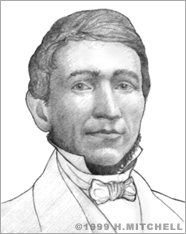Charles Goodyear
Through years of research and a single stroke of luck, Charles Goodyear saved the doomed rubber industry by inventing a process that made the material durable and resilient enough for industrial use.
Goodyear was born in 1800 in New Haven, Connecticut, the son of a hardware store owner. When his father’s business failed in 1830, Goodyear decided to seek his fortune in the new field of rubber products.
Natural rubber (also known as “India rubber” or “caoutchouc”) is a milky sap that can be drained from a variety of tropical trees. After being coagulated with acid, it remains pliant, soft, and sticky. In the first quarter of the 19th century, dozens of American entrepreneurs with “rubber fever” imported the substance (mainly from Brazil) and opened factories to produce rubber products such as baggage and life preservers.
In 1834, Goodyear presented a unique life preserver air valve that he had invented to the manager of a rubber dealership in Philadelphia. The company was not interested in Goodyear’s device and, in fact, regretted ever entering the industry. The unusually hot summer had melted their inventory into a reeking, worthless paste. Melting was not the only shortcoming of natural rubber. Cold makes it stiffen and crack, and even at room temperature, it was too soft to keep its shape and tended to stick to everything it touched.
Goodyear, who was by then obsessed with rubber, was not discouraged. He began experimenting, mixing dry powders into the rubber in order to make it less soft and sticky. Goodyear made some progress but no money. His family nearly starved, and he was jailed for his debts along the way. His first real breakthrough came in 1834, when he discovered that nitric acid made the rubber surface smooth, dry, and non-sticky.
His improved rubber won Goodyear a contract from the U.S. Post Office in Boston. But Goodyear’s rubber mailbags also melted into a sticky mess when the weather was too hot. Poor again, Goodyear kept working. His next breakthrough came when he tried adding sulfur to the rubber. This made the substance less sticky and more resistant to changes in temperature. However, the rubber was still too soft.
In 1839, Goodyear visited a Woburn, Massachusetts general store to try to sell his product there. When the locals laughed at him, he began gesturing wildly, with a lump of his rubber in his hand. By chance, some of the sample flew onto the hot surface of a potbellied stove in the room. Goodyear apologetically began to scrape the rubber off and found that it had become remarkably tough.
This led to another five years of humble experiments in the Goodyear home. Again, the family starved, and the father was imprisoned for debt; he was also so sick that he nearly died. After heating his sulfur-fortified rubber by teakettle, oven, and iron, Goodyear finally perfected the process of pressure steaming, later known as the “vulcanization” (named for the Roman god of fire) of rubber. He was granted U.S. patent #3,633 in 1844, exhibited at the World’s Fairs in the 1950s, and dreamed of a world where practically everything – banknotes, musical instruments, business cards, and clothes – was made of rubber.
Meanwhile, all of the formerly frustrated rubber barons, in the U.S. and abroad, began stealing Goodyear’s process. Goodyear ended up spending most of his time and money in court. He lost European patents on technicalities, and even spent two weeks in a French debtor’s prison before receiving the Cross of the Legion of Honor from Napoleon III. When he died in 1860, Goodyear’s American debts totaled $200,000.
It was only after his death that Goodyear’s wife and children began to earn enough money from royalties to live well. Nor did Goodyear have anything to do with the Goodyear Tire & Rubber Company, named in his honor at its founding in Akron, Ohio in 1898. Although half of the rubber manufactured today is synthetic, the $6 billion per year of American rubber tires and other products might not have been produced at all if it were not for the dedication of Charles Goodyear.
Goodyear would consider that success enough. He once wrote: “I am not disposed to complain that I have planted and others have gathered the fruits. A man has cause for regret only when he sows and no one reaps.”


